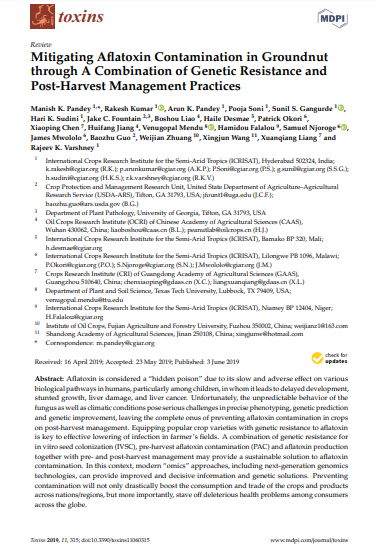Mitigating Aflatoxin Contamination in Groundnut through a Combination of Genetic Resistance and Post-Harvest Management Practices
Summary
This article provides an overview on the complex molecular regulatory events associated with aflatoxin resistance mechanisms in groundnut, with an emphasis on more research on discovery of resistant lines, markers, genes, and pathways which together with pre- and post-harvest management practices can mitigate aflatoxin contamination in groundnuts. Aflatoxin is considered a “hidden poison” due to its slow and adverse effect on various biological pathways in humans, particularly among children, in whom it leads to delayed development, stunted growth, liver damage, and liver cancer. Unfortunately, the unpredictable behavior of the fungus as well as climatic conditions pose serious challenges in precise phenotyping, genetic prediction, and genetic improvement, leaving the complete onus of preventing aflatoxin contamination in crops on post-harvest management. Equipping popular crop varieties with genetic resistance to aflatoxin is key to effective lowering of infection in farmer’s fields. A combination of genetic resistance for in-vitro seed colonization (IVSC), pre-harvest aflatoxin contamination (PAC), and aflatoxin production together with pre- and post-harvest management may provide a sustainable solution to aflatoxin contamination. In this context, modern ‘omics’ approaches, including next-generation genomics technologies, can provide improved and decisive information and genetic solutions. Preventing contamination will not only drastically boost the consumption and trade of the crops and products across nations/regions, but more importantly, stave off deleterious health problems among consumers across the globe.
Open resource Download resource Access resource on external site

